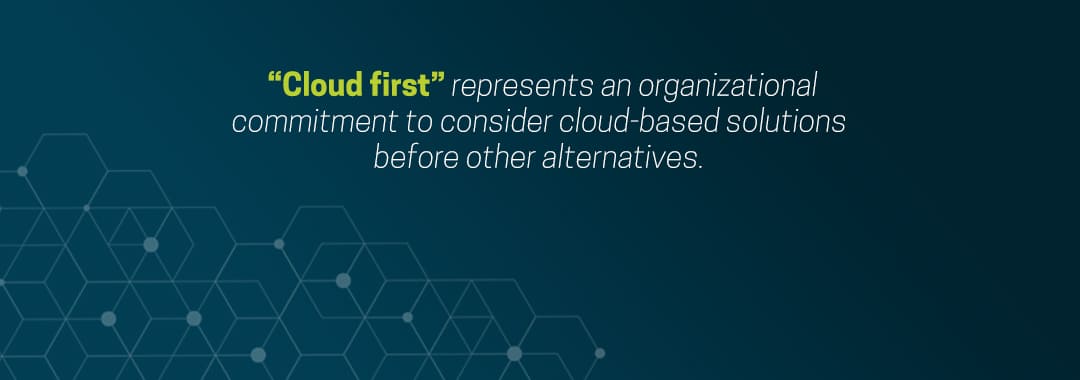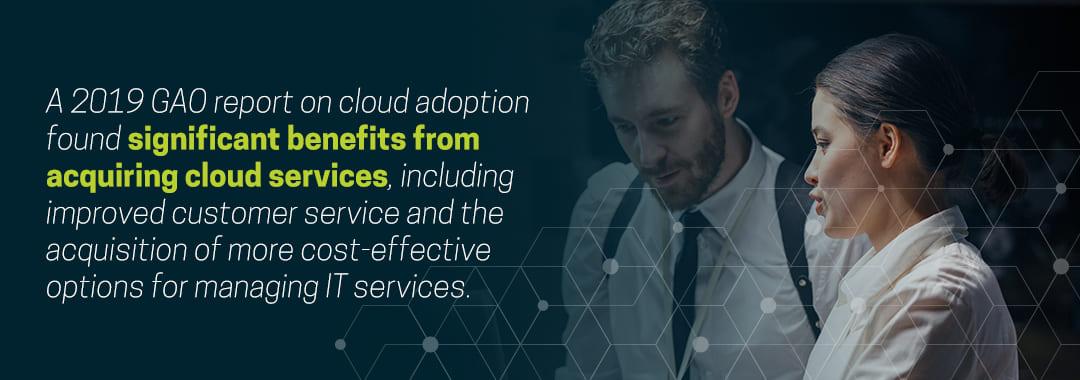Cloud-First: The Smarter Way To Stay Ahead

“Cloud first” is a term used to describe an IT infrastructure strategy. It represents an organizational commitment to consider cloud-based solutions before other alternatives, such as a traditional on-premises approach to implement the use of an application. The “cloud first” moniker is sometimes substituted, or perhaps changed to better reflect the intent as “cloud smart.”
Cloud First and Cloud Smart In Government IT
In most agencies, cloud first is the prevailing philosophy. Within federal computing – which represents much data and application usage – there is a prevailing smart cloud approach driven by the Office of the CIO. In 2019, Suzette Kent, Federal Chief Information Officer, clarified the position of the government in approaching federal computing:
To keep up with the country’s current pace of innovation, there has been significant emphasis on modernizing the Federal government. “By updating an outdated policy, Cloud Smart embraces best practices from both the federal government and the private sector, ensuring agencies have (the) capability to leverage leading solutions to better serve agency mission, drive improved citizen services and increase cyber security.”
The pursuit of cloud-first continues in the federal IT sector, as well as other public and private segments. The federal government states that “the case for using cloud capabilities in government has been clearly proven – to drive savings, to improve security, and to deliver mission-serving solutions faster.”
Unfolding A Cloud First Roadmap
Deferring to cloud computing is a smart strategy as the federal government avidly promotes its cloud-first and cloud-smart strategies to capitalize on cloud computing. In fact, the GSA has established a Cloud Information Center (https://cic.gsa.gov/). It’s a one-stop hodgepodge of useful information.

As you visit the site, you’ll find many important facts to help you and your staff become a cloud ambassador for the extended organization, and better understand the significant advantages that cloud computing affords.
The information they provide on this site serves as a blueprint to integrate a cloud-first approach and creates a convincing case to turn it into a lucrative IT strategy. It keeps pace with the advancement of technology advancements while bringing great efficiency for enterprise data computing.
According to the Cloud Information Center, “The more you have on-premises, the more you and your technology need to be jacks-of-all-trades — you need to handle everything yourselves. But in the cloud’s service-based model, you have access to individualized services optimized for specific functions instead of having one centralized group of servers and staff. That means Cloud Service Providers (CSPs) are focused on providing discrete elements of the cloud experience, and both hardware and software have been designed for performance.”
Cloud-First: An Opportunity?
The Government Accountability Office (GAO) also has something to offer after presenting an in-depth study about cloud adoption.

In April 2019, the GAO published a report examining the status of cloud adoption at 16 agencies. The results were encouraging, if not compelling for cloud-first computing. Here are highlights of what they found:
- GAO reported that 10 of the agencies increased their use of cloud services from FY2016 through FY2019. All 16 agencies had made progress implementing cloud services, meaning they had established assessment guidance, performed assessments, and implemented services, but the extent of their progress varied.
- There was good news from those who adopted cloud first and cloud smart strategies. Specifically, they found that 13 of the 16 agencies saved a total of $291 million to date from using cloud services. And it gets better.
- 15 of the 16 agencies identified significant benefits from acquiring cloud services, including improved customer service and the acquisition of more cost-effective options for managing IT services.
- A key finding had to do with data sharing. They found that sharing data effectively (of everything from weather to facilities) , and capitalizing on such collaboration. The GAO found that 15 of the 16 agencies identified nine cloud investments that enhanced the availability of weather-related information; facilitated collaboration and information sharing among federal, state, and local agencies.
Making A Cloud-First Strategy, Foundational
Cloud computing is well ahead of other strategies as a means to compete and operate in the generation ahead. In 2019, Gartner, in their “6 Steps for Planning a Cloud Strategy,” set the stage and raised the curtain on what cloud computing (and subsequently cloud first) means.
“Cloud has become the foundation that enables businesses to transform, differentiate and gain competitive advantage,” they state.. Many organizations are now focused on cloud-first strategies as they turn their attention to advancing the use of cloud services across the business. Forty percent of organizations in North America alone plan to spend the majority of new or additional funding on cloud, according to a recent Gartner survey.
Gartner is strong in their emphasis on cloud-first as a mandate for CIOs and other leaders seeking to bring their organizations to the next level.
“If you have not developed a cloud-first strategy yet, you are likely falling behind your competitors.”












